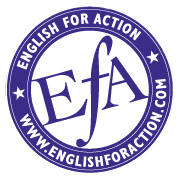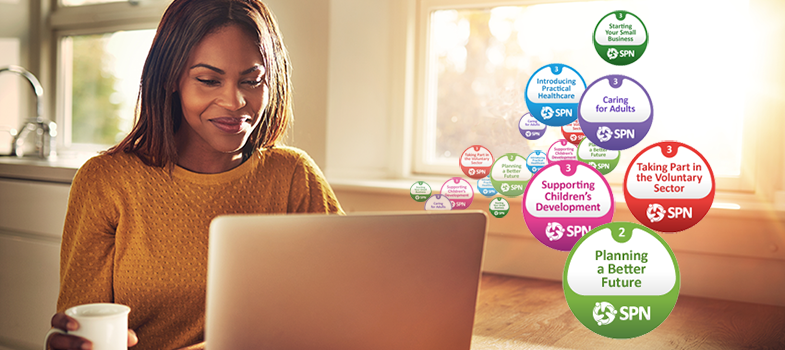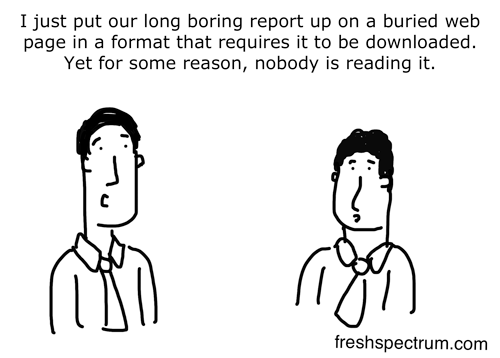Communicating your impact
Once you have measured your impact, it is important to tell people about your results. If you have made a difference then your results can be used to promote your organisation, motivate staff and let others know what works.
It is also important to share your results even if you haven’t made the difference you hoped. Although this can feel daunting, it allows others to learn from them and helps them to feel that you are an honest and transparent organisation. Ultimately your aim is to make a difference to your beneficiaries, so sharing your impact in this way enables voluntary organisations to work together to make an even bigger difference for those people or animals.
People who might be interested in hearing about your results include:
- funders and donors
- staff and volunteers
- beneficiaries
- other voluntary organisations working in a similar area.
The traditional way for voluntary organisations to communicate the results of their impact measurement is in a report – sometimes called an impact report, evaluation report or annual report. However, there are lots of other less formal ways to share information about impact including on a website, in a presentation, through social media or verbally. It is good to make sure that your results are published in a way that people want to receive them and are more likely to read them.
Activity 6
Read the text below from a charity summarising and reflecting on their work and impact in the last year. See if you can identify the following aspects of their work:
- who their beneficiaries are
- what outputs (products or services) they provide
- what impact they have
- how they measure their impact.

Box 3 Reflecting on the past year
English for Action is a charity providing free ESOL classes (English for Speakers of Other Languages) for adults across London. All of our participants are migrants who have English as an additional language. Over the last year our lessons and workshops have been delivered in locations accessible to the participants, such as primary schools, community centres, faith organisations and workplaces. Our courses are free for all participants irrespective of their income, immigration status or nationality.
Last year, over 345 people attended our 18 ESOL courses in the London boroughs of Greenwich, Southwark, Wandsworth, Tower Hamlets and Lambeth. More than 50% of these were receiving ESOL support for the first time. Participants use our classes to learn language, make new friends, find out about local services and to take action that brings about positive change for themselves and the wider community.
In this last year, we have delivered our services through one full-time co-ordinator, 8 part-time teachers and 19 volunteers. We raised over £109,000, including multi-year funding from the Walcot Foundation and Esmee Fairburn.
We asked all of our participants to complete an evaluation form at the end of their course and 97% ‘agreed’ or ‘strongly agreed’ that they had improved their language skills as a result of attending. This supports the results of the informal assessments carried out by our teachers and recorded in the students’ portfolios which showed a profound improvement in language skills. In addition, 151 of our participants achieved an externally accredited ESOL or English Skills qualification.
In the last year we ran 15 class trips to places such as Kew Gardens, Greenwich, Tower Bridge and the South Bank Centre. 91% of participants reported in their evaluation forms that they had made new friends through these trips and the courses in general.
In our classes we discussed and shared information about many local issues that affected our participants including finding work, using libraries, housing, local transport, childcare, benefits, doctors’ surgeries and more. In their evaluation forms, 90% of participants reported that they had a better knowledge of services and facilities in their area after attending our courses. Students often used the words ‘confident’ and ‘confidence’ to talk about how they feel about using the services after the class.
Next year we hope to sustain our existing provision of ESOL classes, support more participants to make changes to improve their living conditions and campaign for wider access to ESOL across the UK.
Discussion
- Who their beneficiaries are:
- their beneficiaries are adult migrants living in London who have English as an additional language.
- What outputs (products or services) they provide:
- they provide ESOL classes and class trips.
- What impact they have:
- participants have improved language skills
- participants make new friends
- participants know more about the local services in their area and feel confident about using them.
- How they measure their impact:
- participants fill out evaluation forms after their course
- teachers complete informal assessments of the participants
- some participants achieve an externally accredited qualification
- teachers listen to the words students use to talk about how they feel after the class.
Measuring your impact

